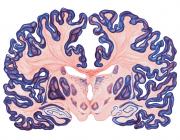Representation of eye movements and stimulus motion in topographically organized areas of human posterior parietal cortex.
Publication Year
2008
Type
Journal Article
Abstract
Recent imaging studies have shown that the human posterior parietal cortex (PPC) contains four topographically organized areas along the intraparietal sulcus (IPS1-IPS4). Using a memory-guided saccade paradigm, we confirmed the locations and retinotopic organization of IPS1-IPS4 and identified two additional areas, IPS5 and superior parietal lobule 1 (SPL1). IPS5 is located at the intersection of the intraparietal and postcentral sulcus; SPL1 branches off the IPS and extends into the superior parietal lobule. Both areas, as well as IPS1-IPS4, each contain a representation of the contralateral visual hemifield. We then probed core functions of the dorsal pathway in these areas, that is, the representation of eye movements and visual motion, to compare the functional characteristics of human PPC to physiologically and anatomically defined areas in monkey PPC. First, as in monkey PPC, a gradient representation of eye movements was found along the IPS with decreasing responses for saccades and increasing responses for smooth pursuit eye movements from posterior/medial to anterior/lateral. The greatest preference for saccades was found in SPL1 and for smooth pursuit in IPS5. Second, and again similar to monkey PPC, all topographically organized PPC areas responded to different types of motion including planar, circular, and radial optic flow, as assessed using adaptation paradigms. Areas in posterior IPS preferred radial optic flow over planar motion, whereas areas in anterior PPC did not show preference for a particular motion type. Together, our results indicate strikingly similar characteristics in the general functional organization of human and monkey PPC, but also reveal some notable differences.
Keywords
Journal
J Neurosci
Volume
28
Pages
8361-75
Date Published
08/2008
ISSN Number
1529-2401
Alternate Journal
J. Neurosci.
PMID
18701699

